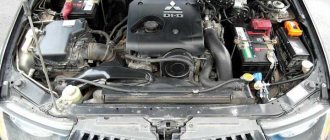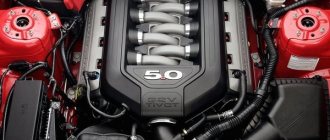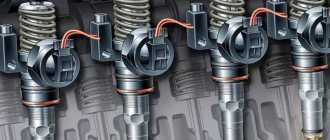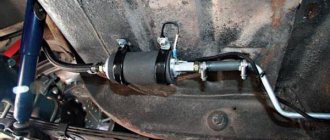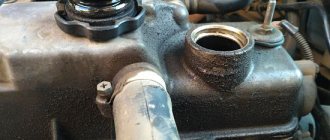When choosing a new or used car, you always pay special attention to the engine. Moreover, not only power or volume is important here, but also the type of motor itself, its design, design, and manufacturer.
The choice of engine directly determines how economical the car will be and how often the owner will encounter malfunctions. That is, the emphasis is on reliability and durability, and the secondary parameters are performance, efficiency and the amount of horsepower.
The engine, which is marked with the letters GDI, looks quite interesting in the eyes of buyers. The abbreviation stands for Gasoline Direct Injection. Here we are talking about a system for direct fuel supply to the engine. An important feature is the fact that the intake does not occur into the manifold, as is done with classic injectors, but directly into the cylinder. Therefore, GDI is naturally and rightly called a combination of diesel and gasoline systems.
Device Features
It has already been roughly described what GDI engines are and what their key features are. But this does not allow us to fully understand the essence of the motor and the features of its design.
Based on the decoding, you understand what a GDI engine means and that the engine uses a combined system typical for gasoline and diesel internal combustion engines. This is a kind of mixture of two different engines, which means it gets a certain advantage over competitors.
It is not entirely obvious to some motorists what a GDI engine is and what its features are in practice. The key nuance is the fact of working on a lean mixture formed in the engine under light loads. These include steady driving at a speed of no more than 120 kilometers per hour. But when the load increases, the system automatically switches to the operation of a classic injection system. Thus, it is possible to achieve better environmental friendliness and efficiency, which for many becomes a decisive factor in their choice.
It is also worth noting that turbo versions of GDI are currently being produced, which additionally received a turbocharger in their design. With its help, it was possible to increase power and performance, but at the same time maintain the ability to consume a small amount of fuel in comparison with competitors. And everyone probably knows what a turbo is in an engine. The GDI engine paired with a turbocharger allows you to get excellent results.
There is a strong opinion among car enthusiasts that the first manufacturers of GDI type engines are the Japanese company Mitsubishi. But in reality this is not the case. The first engine with such a combined injection system was installed on a racing version of the German W196 car produced by Mercedes.
After some time, the Japanese company used an injection system based on electronic control. Thus, they managed to achieve the formation of a lean air-fuel mixture when the engine was running at low loads.
For the first time, Mitsubishi cars with GDI engines went on sale only in 1996. Since that time, the engines have gone through a number of changes and upgrades, since the first samples had a wide range of shortcomings.
In fairness, it should be added that the abbreviation GDI itself is used specifically by the Japanese automaker Mitsubishi. Other companies also have motors with a similar system, but they produce them with different markings. The French automaker Renault uses the concept of IDE, Mercedes uses CGI, and cars from Toyota can be equipped with D4 engines.
Increased volumetric efficiency
Compared to conventional engines, Mitsubishi's GDI engine offers higher volumetric efficiency. Vertical, straight intake ducts create a smoother air intake. The evaporation of fuel that occurs in the cylinder during the final stage of the compression stroke cools the air to improve volumetric efficiency.
Rice. Increased volumetric efficiency
Principle of operation
The operating principle of any internal combustion engine is based on the fact that fuel is supplied and mixed with air, forming an air-fuel mixture. Without the participation of air or oxygen, ignition of the mixture is impossible.
For optimal operation of a gasoline power unit, the mixture must be prepared in a ratio of 14.7 to 1. That is, 1 gram of fuel is required for 14.7 grams of air. If the amount of air exceeds the specified norm, the mixture is considered lean. If there is less air, then the mixture is rich.
By running the engine on a lean mixture, fuel consumption can be significantly reduced. But since there is quite a small amount of fuel in it, it is more difficult to ignite such a substance. Problems arise due to the inability to ignite the mixture.
But a mixture supersaturated with fuel ignites very easily. But at the same time, the gasoline does not burn out completely, and the unburned part comes out along with the exhaust. Hence the excessive consumption of fuel and irrational use of gasoline. An additionally enriched mixture contributes to the accumulation of carbon deposits on engine valves and spark plugs.
Considering all these points, you can understand the operating principle of GDI engines and understand their distinctive features. The design difference is that it involves injection not directly into the intake manifold, as happens on conventional injection gasoline engines, but directly into the combustion chamber. This principle is borrowed from diesel engines.
The operation of GDI can be described as follows:
- Gasoline enters the combustion chamber under high pressure. At the same time, the flow itself is characterized by a twisted shape, which is achieved through the use of special nozzles. They differ from ordinary ones in their structure.
- The flow of fuel under high pressure meets resistance from the piston. A collision occurs. This allows some of the fuel to remain on the surface of the piston. The remaining amount of gasoline continues to move further, creating a friction force and taking on a certain shape.
- Then the flow bends and moves away from the piston with a parallel increase in speed. Some particles move more slowly, and they begin to diverge to the sides, thereby dividing the flow.
- As a result, two sections with an air-fuel mixture are simultaneously formed inside the combustion chamber. In the middle there is a zone with a regular flammable mixture, and around there is a depleted substance.
- The cycle ends with ignition, which is formed due to the operation of a spark plug borrowed from an injection gasoline engine. First, the area with the standard mixture lights up, and then the lean fuel and air burns.
Engine 4G93 GDI
It is worth talking about it separately. What kind of motor is this? The 4G93 is a two-liter four-cylinder unit that has been in mass production for 20 years. Maximum power, depending on modifications, is from 160 to 215 horsepower. Initially it was carburetor and then injection. In the early 2000s, this engine was equipped with direct injection. The unit has a two-shaft cylinder head with a timing belt drive. The motor is also equipped with hydraulic compensators.
As reviews note, the Mitsubishi GDI engine may have problems with the pumps. There are only two of them. This is a low and high pressure fuel pump. Often problems arise with the latter. Thus, the fuel injection pump becomes clogged with solid particles found in the fuel. As a result, the car stalls when you press the gas pedal and during any attempts to accelerate. At the same time, at idle speed, Mitsubishi GDI engines can behave normally. In such a situation, detailed diagnostics and cleaning of the pump elements is required.
Among other problems of this motor it is worth noting:
- Problems with the gas recirculation valve. The intake manifold on this engine requires regular cleaning.
- Filling spark plugs. This happens in severe frosts when trying to start the engine “cold”.
- Engine knock. This happens due to faulty hydraulic compensators. Because of this, the valve clearance is not normal.
Distinctive features
To understand the difference between GDI and conventional injection systems, you need to consider the distinctive characteristics of this engine. This way you will be able to find out the key points regarding a gasoline engine with direct injection.
- The injection process is carried out under pressure, which has parameters of 50 atmospheres or more. In classic injection engine systems, the pressure is about 3 atmospheres. This feed allows you to create a fine mist when spraying.
- There are some design differences related to the throttle valve. In GDI type motors it is installed a little further.
- The fuel is supplied directly to the working cylinder itself, where a mixture of fuel and air is formed. And on conventional engines, the supply occurs through the intake manifold, which is also necessary to create the air-fuel mixture.
- The design of the pistons includes spherical recesses. Due to it, it becomes possible to create turbulence and control the flame during fire. Additionally, the recess is needed to control the creation of the mixture, regulating the required volume of air and fuel when they are combined into the mixture.
- GDIs allow you to create very lean mixtures. On modern engines, it is possible to operate efficiently even on a mixture whose proportions are up to 43 to 1. This is despite the fact that classic fuel systems have a typical ratio of 14 to 1.
- Special vortex nozzles are installed in the cylinder head. With their help, you can create swirling flows. As a result, the flow moves along a strictly specified direction and trajectory.
- GDI engines are characterized by the ability to operate in 2 different modes. This is normal, like a standard injector, and lean. Moreover, the transition from one mode to another occurs automatically. When the load on the engine is increased, that is, they begin to move at a higher speed, an enriched mixture is supplied. In quiet mode, the lean mixture burns, thereby saving fuel.
- In the composition of such a motor, the fuel injection pump necessarily takes part. Moreover, the high-pressure fuel pump receives special attention, since it acts as a key element in the operation of the direct injection system on GDI and the like. The pump affects the quality of operation of the power plant and its overall performance.
Everything looks very interesting and attractive from the perspective of a potential buyer of a car with such an engine. But for objectivity, you need to consider the strengths and weaknesses of the GDI motor. This will allow you to fully evaluate the capabilities of the engine, taking into account all the existing shortcomings. And then it will become clear whether such a car is worth buying or not.
Summarize
I am an opponent of direct gasoline injection technology. Yes, these engines are more economical than conventional fuel-injected internal combustion engines, more powerful and efficient. But they are more capricious and expensive to maintain. Filled with bad fuel - threw out the injectors or injection pump. More often, the intake valves and manifold become clogged - interruptions in the operation of the power unit and loss of power. It needs to be cleaned more often, which is an extra expense.
Many people say: “Jidai engines lend you money with their economy and performance.” That is, the time comes for maintenance, and you return them to him in full.
Therefore, draw your own conclusion. I made them for myself - it’s better to buy a car with distributed gasoline injection than with a GDI engine . This will save me nerves, time and money on maintenance and repair of the fuel system.
Share:
Main advantages
By examining the pros and cons of GDI engines, some conclusions can be drawn regarding these powerplants and the fuel delivery system used.
The engine receives all its key advantages precisely from the ability to operate on a leaner mixture at low and medium loads. Changing the fuel to air ratio reduces the amount of fuel consumed. Studies have shown that in the urban cycle, during long-term operation at approximately the same speed, consumption drops by 20-25%. But GDI no longer receives similar benefits on the track, when the speed and load on the engine increases. Here the consumption remains at the level of conventional injection systems.
Another advantage is the mixture formation process that occurs inside the combustion chamber. Any engine repair and maintenance specialist will tell you that the combustion process in the cylinders always occurs unevenly. A larger amount of fuel burns near the candle. But in distant areas, the fuel may not burn out, resulting in residues exiting through the exhaust system.
GDIs do not have this drawback, just like modern TSI engines. Layer-by-layer injection technology is used here. As a result, this allows up to 5 portions of fuel to be injected in 1 stroke, forming a heterogeneous mixture in the cylinders, taking into account the specific characteristics of combustion. This helps reduce consumption, reduce the toxicity of exhaust emissions, and also maintain stability at low and medium engine speeds.
Basic concept
In conventional gasoline engines, it would be difficult to ensure that the air-fuel mixture is sprayed at an ideal density around the spark plug. However, this is made possible in the GDI engine. In addition, extremely low fuel consumption is achieved because ideal stratification allows fuel introduced late in the compression stroke to support the combustion of ultra-lean air-fuel mixtures.
During engine testing, it was shown that the air-fuel mixture with optimal density is collected around the spark plug in the form of a stratified fuel charge. This was also confirmed by analyzing the behavior of the fuel jet immediately before ignition and analyzing the instantaneous composition of the air-fuel mixture.
The result is extremely stable ultra-lean combustion with an air-fuel ratio of 40:1 (55:1 when EGR is turned on).
Characteristic disadvantages
But no system can do without certain disadvantages. Therefore, it is worth finding out in advance why a GDI type engine is so bad, what its main drawback is and how much the disadvantages outweigh the advantages, or vice versa.
Let's start with the fact that the GDI engine uses a more complex fuel intake system, the design of which includes an injection pump similar to those used on diesel engines. The result is a disadvantage in the form of increased sensitivity to the quality of the fuel used. This refers to the inclusion of various solid components, compounds of iron, phosphorus, sulfur and other substances in gasoline. If you regularly fill with low-quality fuel, the engine will begin to break down.
An engine with a direct injection system has another drawback. It lies in the fact that the technology is quite specific, and only a limited number of car services can offer their services for the repair and maintenance of such internal combustion engines.
Repair procedures are distinguished by their complexity compared to conventional injection engines with a distributed type of injection.
Owners of cars with GDI power units are faced with the fact that there are a small number of spare parts on the market. Parts for them are not particularly common in our country yet. Therefore, sometimes, when a breakdown occurs and the need to replace an element, you have to order it and wait for several weeks, which automatically does not allow you to operate the machine.
Considering all these points, you need to carefully think about the rationality of purchasing such an engine, since you will have to resolve the issue of repair, maintenance and finding good gas stations.
Fuel consumption at idle
The GDI engine maintains stable combustion even at low idle speeds. Moreover, it provides greater flexibility in idle speed control. Its fuel consumption in this mode is 40% less compared to conventional engines.
Rice. Fuel consumption at idle
Problems and malfunctions
In fact, almost all the problems that a GDI engine has are related to the issue of sensitivity to low-quality gasoline. This feature leads to various breakdowns and malfunctions.
As the experience of car owners shows, spark plugs on GDI engines begin to turn black and fail. The fuel system does not like water, various mechanical impurities and solid mineral particles getting inside.
Carbon deposits also appear on the surfaces of valves and intake manifolds. As a result, the process of formation of the mixture changes, which is due to a violation of the trajectory of flow movement inside the cylinder. All this leads to a decrease in power and interruptions.
In order not to provoke such malfunctions, and to ensure long-term and efficient operation of the GDI motor, it is recommended to carry out some preventive measures. They boil down to compliance with the following rules:
- It is recommended to change spark plugs before malfunctions occur. In our operating conditions, the optimal service interval is considered to be 10-20 thousand kilometers.
- Additionally, it is recommended to clean the intake manifold of accumulated carbon deposits and soot. This is done at least once every 25-30 thousand kilometers.
- Be sure to monitor the condition of the injectors, check the quality of fuel atomization and clean the injectors.
Considering the existing shortcomings, it is hardly worth saying that when using GDI it is extremely important to visit only proven and well-established gas stations that offer the highest quality, clean and undiluted fuel.
Emission control
Previous attempts to burn lean air-fuel mixtures have led to difficulties in controlling NOx emissions. However, the GDI engine achieves a 97% NOx reduction using a high level of exhaust gas recirculation (EGR) of around 30%. This result is achieved thanks to the uniquely stable combustion of fuel in the GDI engine, as well as the newly developed lean nitrogen oxide catalyst. The figure shows the NOx emissions graph for this engine, the figure below shows the lean nitrogen oxide catalyst.
Rice. Nitrogen oxide emissions
Rice. Newest Lean Nitrogen Oxide Catalyst
Rationality of purchase
Potential buyers are attracted to cars with direct fuel injection, which is used in the GDI system, for their efficiency, good traction and excellent power performance. But as a counterbalance, several disadvantages can be put at once, due to a decrease in reliability under the influence of low-quality fuel.
Objectively, the operation of such engines in our conditions can lead to the fact that the owner will need to regularly visit a service station, spend a lot of money on repairs and wait a long time for the delivery of the necessary spare parts.
But this was true before. Currently, the situation is changing for the better. Engines produced by foreign manufacturers undergo an adaptation procedure. This allows you to reduce sensitivity to the quality of gasoline, process even poor fuel and reduce the number of problems.
Adapted GDI can be safely refueled at all fairly good gas stations, without fear that some impurities will lead to very rapid engine failure with subsequent impressive material costs to restore the performance of a power plant with a direct fuel injection system.
Whether to buy vehicles with such engines or not is up to each individual. Engines that have undergone adaptation are much more attractive than European or Japanese versions. There are a number of benefits you can get from GDI. The owner only needs to remember the risks of visiting dubious gas stations, and also follow all prescribed recommendations and advice on operation, maintenance and replacement of consumables. Under such conditions, GDI will show all its best qualities, and you are unlikely to remember its characteristic shortcomings.


